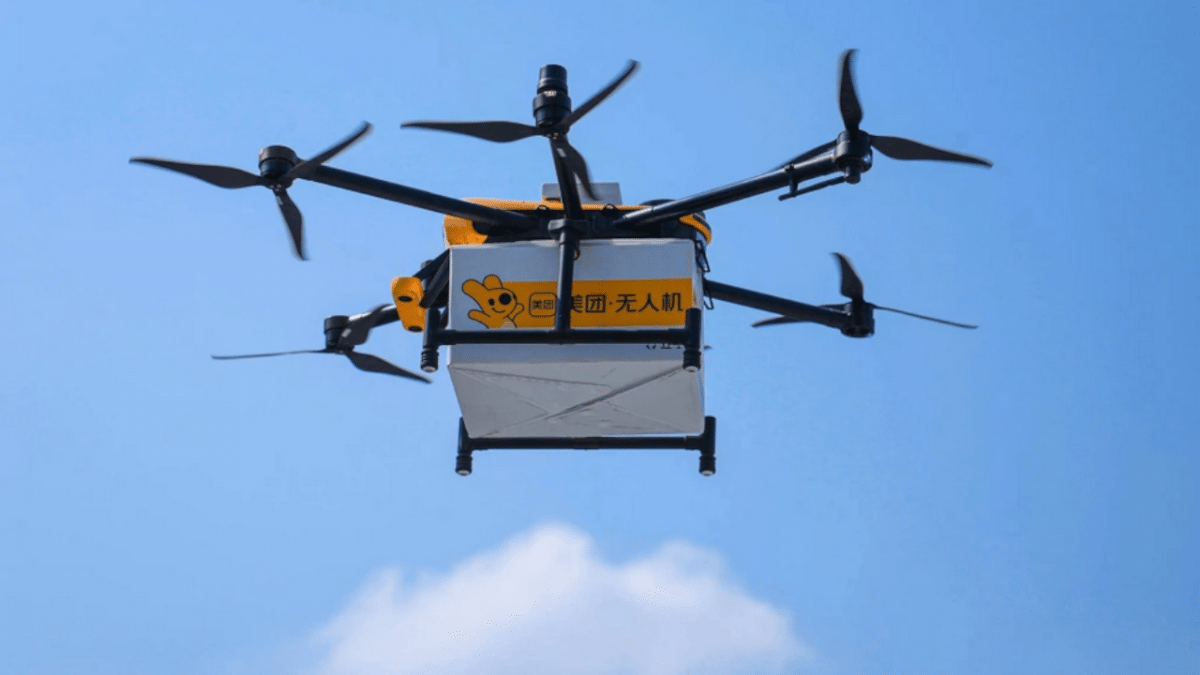My iced tea came floating down from the sky. In a busy neighborhood in Shenzhen, China, I watched as a yellow and black drone approached a streetside pick-up kiosk among several skyscrapers. The top of the kiosk, the size of a vending machine, opened and the landing drone placed a white carton of my drink inside. When I placed the order on my phone half an hour earlier, the app wrote me that the drink would be delivered at 2:03 p.m. by drone. That’s when it arrived.

Zeyi Yang is a reporter for the US edition of MIT Technology Review in China and East Asia. From there he regularly reports on technology topics.
The drone delivery service I tried is operated by Meituan, China’s most popular food delivery platform. In 2022, the company employed around six million gig delivery employees who delivered billions of orders. But since 2017, the company has also been working on drone deliveries. For the past year and a half, Meituan has regularly operated such delivery routes in Shenzhen, a city in southeast China with a mature supply chain for drones.
Many big companies have their eye on delivery drones. Amazon first proposed this in 2013, but progress has been limited by regulations and lack of demand. Wing, which is owned by Google parent Alphabet, has had more success, offering drone deliveries on three continents. Finally, Walmart is supporting several drone startups to experiment with shipping its products.
Deliveries by drone in densely populated urban areas
What sets Meituan apart from these U.S. companies is that it chose to offer drone delivery in what is potentially a very difficult environment: dense urban neighborhoods. But this approach actually makes sense in China, where most people live in high-rise buildings in populous cities, and many of them order food deliveries on a daily basis.
To ensure that the service also works in a densely built-up city, Meituan does not have the drones delivered directly to the front door. Instead, the company has set up pickup kiosks near residential or office buildings. The drones drop off the supplies at the kiosks, which can hold multiple packages at once. The process might be less convenient for customers, but it allows each drone to fly a pre-determined route from a launch pad to a kiosk, making navigating urban areas much easier.
In 2022, Meituan completed more than 100,000 drone deliveries in Shenzhen. My own experience has not been smooth. When I first tried to use the service, I accidentally ordered from a restaurant that was too far away. My second attempt failed because I unknowingly ordered after hours (the drones go to bed at 7pm).
But for some Shenzhen residents and traders, delivery by drone is no longer a novelty but a part of everyday life. Meituan’s advances show that regular urban deliveries are possible, albeit with some compromises in terms of usability. To find out how she pulls off this trick, I visited one of the company’s drone launch sites.
Airport for drones on a mall
Meituan launches its drones from five delivery centers in Shenzhen. My tea came from a center just a few hundred yards away on top of a huge mall. There, the roof of the building was converted into an airport for the drones and a handful of employees.
When I visited in April there were about ten drones parked on the roof while two to three were just taking off or landing. As a Meituan staffer told me, I had just missed the busy midday peak, and the drones and people there were resting and charging ahead of the evening peak.
The workflow is a mixture of human and automated work. Once the drone delivery system receives an order (customers order specific items that are marked for drone delivery in the company’s app), an employee goes to the restaurants, each located a few floors down in the mall, to pick up the order and bring it to the starting point. This person places the food and drinks in a standardized carton, weighs it to make sure it’s not too heavy, seals the carton, and hands it over to another employee who specializes in handling drones. This places the box under a drone until it clicks into place.
Everything else is highly automated, says Mao Yinian, Meituan’s head of drone delivery services. The movements of the drones are controlled by a central algorithm and the routes are predetermined. “You know in advance, up to the second, where each drone will be and how fast it will be, so customers can expect the arrival time with an error of two seconds, instead of three minutes or even ten minutes with traditional delivery,” says he.
